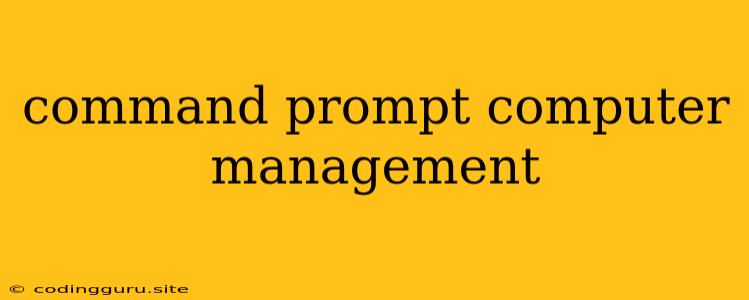Command Prompt: Your Gateway to Computer Management
The Command Prompt, also known as cmd.exe, is a powerful tool built into Windows operating systems. It provides a text-based interface for interacting with your computer, allowing you to execute commands and manage system files, processes, and settings. While the graphical user interface (GUI) offers a visually intuitive approach to computer management, the Command Prompt provides a more direct and efficient way to accomplish tasks.
Why Use Command Prompt?
- Increased Efficiency: For repetitive tasks or complex operations, the Command Prompt can save you time and effort. You can automate processes by creating batch scripts and using the power of command-line arguments.
- Advanced System Control: The Command Prompt grants you deeper access to your computer's core functions. You can modify system settings, troubleshoot issues, and even manage network connections.
- Troubleshooting Power: When facing software or hardware issues, the Command Prompt allows you to directly analyze system logs, diagnose network connectivity, and identify potential problems.
- Remote Management: You can use the Command Prompt to manage other computers on your network or even access a remote server, making it an essential tool for system administrators.
Navigating the Command Prompt
The Command Prompt uses a simple yet powerful structure based on commands and arguments.
-
Opening the Command Prompt: You can access the Command Prompt by searching for "cmd" in the Windows search bar.
-
Basic Commands:
dir- Lists files and directories in the current directory.cd- Changes the current directory. Usecd ..to move one level up.help- Displays a list of available commands.cls- Clears the screen.exit- Closes the Command Prompt window.
-
File Management:
copy: Copies files. For example:copy file1.txt file2.txtcopies file1.txt to a new file named file2.txtmove: Moves files or directories. For example:move file1.txt c:\tempmoves file1.txt to the c:\temp directory.del: Deletes files. Be cautious, this command permanently deletes files. Use the/fswitch to force deletion of read-only files.mkdir: Creates a new directory. For example:mkdir newfoldercreates a directory named newfolder in the current location.rmdir: Removes a directory. It must be empty to be removed.
-
Advanced Commands:
ping: Tests network connectivity.ipconfig: Displays network configuration information.netstat: Shows network connections and listening ports.tasklist: Lists running processes.taskkill: Terminates a running process.
Examples of Using the Command Prompt
1. Creating a new folder and moving files:
* **`mkdir myNewFolder`** - Creates a new folder named "myNewFolder".
* **`cd myNewFolder`** - Changes to the newly created folder.
* **`move file1.txt file2.txt myNewFolder`** - Moves two files into the "myNewFolder" folder.
2. Checking network connectivity:
* **`ping google.com`** - Sends network packets to google.com and displays results.
3. Listing all running processes:
* **`tasklist`** - Shows a list of all processes running on your system.
4. Stopping a specific process:
* **`taskkill /IM notepad.exe`** - Terminates the Notepad process.
5. Creating a batch file:
* Create a new text file and save it with a `.bat` extension.
* Inside the file, type the commands you want to execute, for example:
```batch
@echo off
cls
dir
pause
```
* Save the file and run it by double-clicking the file.
Tips for Effective Command Prompt Usage:
- Practice and Experiment: The best way to learn the Command Prompt is to experiment with different commands.
- Utilize
help: If you're unsure of a command's usage, typehelp [command]for detailed information. - Use Tab Completion: Press the
Tabkey to automatically complete a partially typed command or file name. - Create Batch Files: Automate tasks by writing batch scripts. These files contain a sequence of commands that can be executed together.
- Don't Fear Mistakes: The Command Prompt is designed for experimentation. If you make a mistake, you can usually recover by using the
cdcommand to navigate to the correct directory.
Troubleshooting:
- Invalid Command: If you encounter an "invalid command" error, make sure you've spelled the command correctly and that the correct syntax is used.
- Access Denied: If you receive an "Access Denied" error, you may need to run the Command Prompt as administrator. Right-click the Command Prompt icon and select "Run as administrator".
- File Not Found: Double-check the file name and path to ensure they're correct.
- Syntax Error: Pay close attention to the spacing and syntax of commands.
Conclusion
The Command Prompt may seem daunting at first, but with practice and exploration, you can unlock its power and become a more efficient and skilled computer user. This powerful tool provides direct access to your computer's core functions, offering greater control and flexibility in managing your system.
